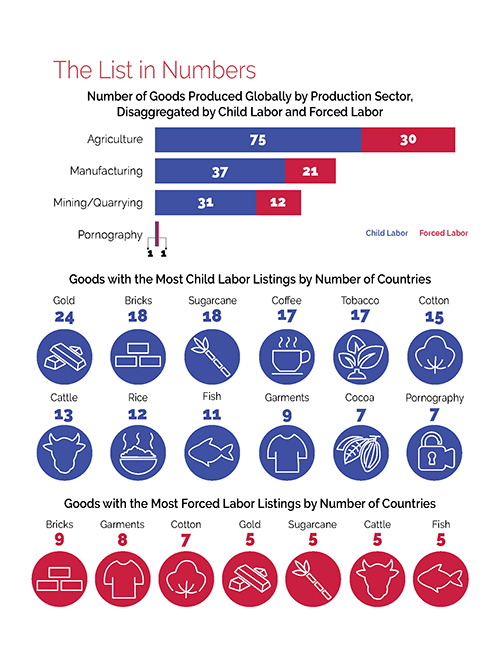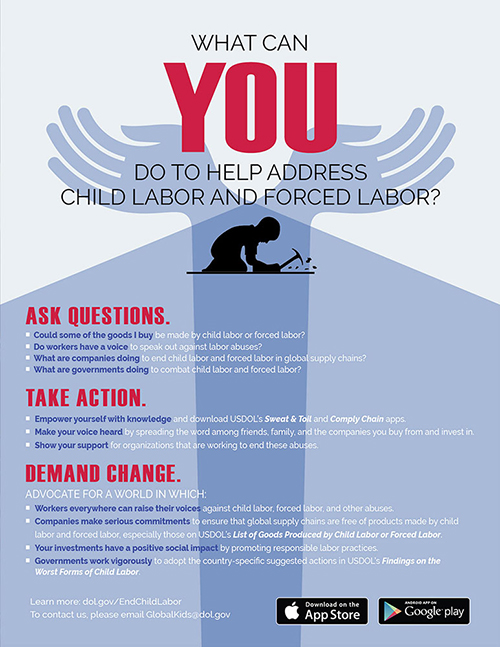List of Goods Produced by Child Labor or Forced Labor
The Bureau of International Labor Affairs (ILAB) maintains a list of goods and their source countries which it has reason to believe are produced by child labor or forced labor in violation of international standards, as required under the Trafficking Victims Protection Reauthorization Act (TVPRA) of 2005 and subsequent reauthorizations. The List of Goods Produced by Child Labor or Forced Labor comprises 159 goods from 78 countries and areas, as of September 28, 2022.
ILAB maintains the List primarily to raise public awareness about forced labor and child labor around the world and to promote efforts to combat them; it is not intended to be punitive, but rather to serve as a catalyst for more strategic and focused coordination and collaboration among those working to address these problems.
Publication of the List has resulted in new opportunities for ILAB to engage with foreign governments to combat forced labor and child labor. It is also a valuable resource for researchers, advocacy organizations and companies wishing to carry out risk assessments and engage in due diligence on labor rights in their supply chains.
The countries on the List span every region of the world. The most common agricultural goods listed are sugarcane, cotton, coffee, tobacco, cattle, rice, and fish. In the manufacturing sector, bricks, garments, textiles, footwear, carpets, and fireworks appear most frequently. In mined or quarried goods, gold, coal and diamonds are most common.
ILAB published the initial TVPRA List in 2009 and updated it annually through 2014, following a set of procedural guidelines that were the product of an intensive public consultation process. ILAB now updates and publishes the List every other year, pursuant to changes in the law.
Procedural Guidelines
On January 25, 2024, ILAB's Office of Child Labor, Forced Labor, and Human Trafficking published Procedural Guidelines for the development and maintenance of the List of Goods from countries produced by child labor or forced labor in violation of international standards.
| Country/Area | Good Sort descending | Exploitation Type |
|---|---|---|
| Cambodia | There is evidence that children between the ages of 5 and 14 engage in the production of bovines in Cambodia. In Cambodia, bovines are primarily used for domestic consumption and for farming purposes, and are raised by approximately 1.4 million smallholders primarily located in provinces bordering the Mekong River, with a heavy concentration found in the southern rice-producing provinces. Based on analysis of the 2016 Cambodian Socio-Economic Survey, an estimated 59,693 children are involved in child labor in the production of bovines. The release of this survey demonstrates the Government of Cambodia’s commitment to addressing child labor and its acknowledgment that data collection is vital to the design and implementation of sound policies and programs. |
Child Labor |
| Ecuador | There are reports that children ages 5 to 17 work in bovine raising in Ecuador. Based on the analysis of Ecuador’s 2019 National Survey of Employment, Unemployment, and Underemployment, an estimated 10,564 children under the minimum age for work are involved in child labor in bovine raising. The ILO has found that generally, children who care for farm animals may be at risk of exposure to potential health consequences, including injuries from kicks and infections from animal bites and exposure to harmful bacteria. The release of this survey demonstrates the Government of Ecuador’s commitment to addressing child labor and its acknowledgement that data collection is vital to the design and implementation of sound policies and programs. |
Child Labor |
| Eswatini | There is evidence that children ages 8 to 17 raise bovines in Eswatini. Child labor in this sector is concentrated in the rural areas of Hhohho, Lubombo, Manzini, and Shiselweni. In 2018, the Government of Eswatini and the International Labor Organization published results from the 2014 Survey on Child Labor in Herding in Rural Areas in Eswatini. According to international standards on the minimum age for work, children working below the age of 15 are engaged in child labor. The survey estimates that 72,332 children below the age of 15 raise bovines. Children perform physically arduous tasks while herding in the grasslands and mountainous regions, and risk occupational injury and disease from exposure to dangerous tools, insecticides and herbicides. Children’s injuries include fractures, dislocations and sprains, burns, frostbite, breathing problems, skin problems, extreme fatigue, and snake bites. The release of this survey demonstrates the Government of Eswatini’s commitment to addressing child labor and its acknowledgement that data collection is vital to the design and implementation of sound policies and programs. |
Child Labor |
| Ghana | There is evidence that children ages 5 to 14 are involved in the raising of bovines in Ghana. Based on an analysis of the Ghana Living Standards Survey, an estimated 10,049 child laborers are involved in the raising of bovines. The ILO has found, depending on the conditions, that herding, shepherding, and handling livestock may be considered as hazardous work. Injuries from animals include being bitten, butted, jostled, stamped on, gored, or trampled. Large and small animals do not need to be aggressive to cause serious harm or even kill a child. Children rarely wear protective shoes or boots, and this increases their risk for additional injuries and illnesses such as cuts, wounds, bruises, thorn injuries, skin disorders, and infections. Diseases can be contracted through routine contact with animals, insects, pathogens in animal carcasses, and work near livestock stabling areas and butchering houses. The release of this survey demonstrates the Government of Ghana’s commitment to addressing child labor and its acknowledgement that data collection is vital to the design and implementation of sound policies and programs. |
Child Labor |
| Pakistan | There is evidence that children under the age of 14 raise bovines in Pakistan. An analysis of the Pakistan Labour Force Survey 2017–2018 considers all work performed by children under age 14 to be child labor. Based on an analysis of the survey, it is estimated that 31,516 child laborers raise bovines. The ILO has found that generally, children who work in livestock cultivation may be at risk of exposure to hazards including working long hours, being injured by the animals, and exposure to the elements, diseases, and chemicals such as disinfectants. The release of this survey demonstrates the Government of Pakistan’s commitment to addressing child labor and its acknowledgment that data collection is vital to the design and implementation of sound policies and programs. |
Child Labor |
| India | Child Labor | |
| Bolivia | There are reports that children are forced to harvest Brazil nuts in Bolivia. Forced child labor in the production of Brazil nuts is known to be found in the Amazon region in particular, and migrant workers are particularly vulnerable. According to international organizations, NGOs, and the U.S. Department of State, many children are forced to work, often with their families, under conditions of bonded labor. Often entire families, including children, are given an advance payment to work in the harvest, and then incur more debt during the harvest. The families are prohibited from leaving, even once the harvest is complete, until their debts are paid off. Sometimes identity papers and wages are withheld as a means to restrict freedom of movement. |
Child Labor, Forced Labor |
| Peru | Forced Labor | |
| Afghanistan | Child Labor, Forced Labor | |
| Argentina | Child Labor |
your hand? Download ILAB's Sweat & Toil App today!
Are you a company looking to fight child labor and forced labor in supply
chains?





